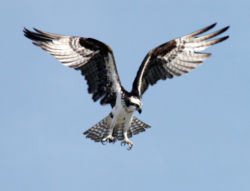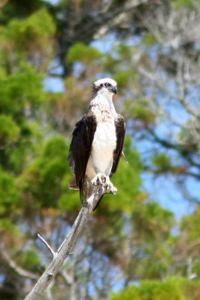|
Osprey Conservation status Least concern |
||||||||||||||
|---|---|---|---|---|---|---|---|---|---|---|---|---|---|---|

A North American Osprey preparing to
dive.
|
||||||||||||||
| Scientific classification | ||||||||||||||
|
||||||||||||||
| Pandion haliaetus (Linnaeus, 1758) |
The Osprey (Pandion haliaetus) is a medium large raptor which is a specialist fish-eater with a worldwide distribution. It occurs in all continents except Antarctica, but in South America only as a non-breeding migrant. It is often known by other colloquial names such as fishhawk, seahawk or Fish Eagle.
An unusual bird with no close relatives, it is the only living species of the genus Pandion, which is in turn the only genus in the bird family Pandionidae.
Contents |
Description
The Osprey is 52-60 centimetres (20.5-23.6 in) long with a 152-167 cm (5-5.5 ft) wingspan. It has mainly white underparts and head, apart from a dark mask through the eye, and fairly uniformly brown upperparts. Its short tail and long, narrow wings with four long "finger" feathers (and a shorter fifth) give it a very distinctive appearance.
Juvenile birds are readily identified by the buff fringes to the upperpart plumage, buff tone to the underparts, and streaked crown. By spring, wear on the upperparts makes barring on the underwings and flight feathers a better indicator of young birds. Adult males can be distinguished from females from their slimmer bodies and narrower wings. They also have a weaker or non-existent breast band than the female, and more uniformly pale underwing coverts. It is straightforward to sex a breeding pair, but harder with individual birds.
In flight, Ospreys have arched wings and drooping "hands", giving them a diagnostic gull-like appearance. The call is a series of sharp whistles, cheep, cheep, or yewk, yewk. Near the nest, a frenzied cheereek!
Classification
The Osprey differs in several respects from the other diurnal birds of prey, and has always presented something of a riddle to taxonomists. Here it is treated as the sole member of the family Pandionidae, and the family listed in its traditional place as part of the order Falconiformes. Other schemes place it alongside the hawks and eagles in the family Accipitridae—which itself can be regarded as making up the bulk of the order Accipitriformes or else be lumped with the Falconidae into Falconiformes. The Sibley-Ahlquist taxonomy has placed it together with the other diurnal raptors in a greatly enlarged Ciconiiformes, but this has more recently turned out to result in an unnatural paraphyletic classification.

There are four generally recognised subspecies, although differences are small, and ITIS only lists the first two.
- P. h. haliaetus (Linnaeus, 1758) Eurasia
P. h. carolinensis (Gmelin, 1788), North America. This form has a paler breast than nominate haliaetus.
P. h. ridgwayi Maynard, 1887, Caribbean islands. This form has a very pale head and breast compared to nominate haliaetus, with only a weak eye mask. It is non-migratory.
P. h. cristatus (Vieillot, 1816), Australasia. The smallest subspecies, also non-migratory
Ospreys are unusual insofar as a single species occurs nearly worldwide. Even the few subspecies are not unequivocally separable. The reason is apparently that these birds are usually migratory, enabling individuals from populations which breed far apart to meet in the winter quarters, form pairs and thus exchange genetic information between populations. Furthermore, Ospreys are long-lived birds which take a considerable time to reach maturity, which slows down the rate of speciation.
Prehistoric species
There were several prehistoric species of osprey which have been described from fossils:
- Pandion sp. (Early Oligocene of Fayyum, Egypt)
- Pandion homalopteron (Middle Miocene of California, USA)
- Pandion lovensis (Late Miocene of Florida, USA)
- Pandion sp. (Late Miocene/Early Pliocene of Lee Creek Mine, USA)
P. homalopteron was very similar to the living species and possibly even its direct ancestor. However, the biogeography of the fossil ospreys has not been researched well enough to suggest a place where the modern Osprey originated. The genus apparently first appeared in the Mediterranean region, but this is not certain.
Behaviour
Diet
The Osprey is particularly well adapted to its fish diet, with reversible outer toes, closable nostrils to keep out water during dives, and backwards facing scales on the talons which act as barbs to help hold its catch. It locates its prey from the air, often hovering prior to plunging feet-first into the water to seize a fish. As it rises back into flight the fish is turned head forward to reduce drag. The 'barbed' talons are such effective tools for grasping fish that, on occasion, an Osprey may be unable to release a fish that is heavier than expected. This can cause the Osprey to be pulled into the water, where it may either swim to safety or succumb to hypothermia and drown.
Nesting
The Osprey breeds by freshwater lakes, and sometimes on coastal brackish waters. The nest is a large heap of sticks built in trees, rocky outcrops, telephone poles or artificial platforms. In some regions with high Osprey densities, such as Chesapeake Bay, USA, most Ospreys do not start breeding until they are five to seven years old. Many of the tall structures they need to build nests on are already taken. If there are no nesting sites available, young Ospreys may be forced to delay breeding. To ease this problem, posts may be erected to provide more sites.
Ospreys usually mate for life. In spring they begin a five-month period of partnership to raise their young. Females lay 3–4 eggs within a month, and rely on the size of the nest to help conserve heat. The eggs are approximately the size of chicken eggs, and cinnamon colored; they are incubated for about 5 weeks to hatching.
The newly-hatched chicks weigh only 50-60 g (2 oz}, but fledge within eight weeks. When food is scarce, the first chicks to hatch are most likely to survive. The typical lifespan is 20-25 years.
European breeders winter in Africa. American and Canadian breeders winter in South America, although some stay in the southernmost USA states such as Florida and California. Australasian Ospreys tend not to migrate.
Conservation
Twenty to thirty years ago, Ospreys in some regions faced possible extinction, because the species could not produce enough young to maintain the population. Since the banning of DDT in many countries in the early 1970s, together with reduced persecution, the Ospreys, as well as other affected bird of prey species have made significant recoveries.
Popular culture
The Osprey is the official bird of Nova Scotia in Canada and Sudermannia in Sweden. It is the official mascot and team name for the University of North Florida and the Richard Stockton College of New Jersey. The bird was depicted on the 1986 series Canadian $10 note. The Osprey is also the mascot of the Christian Falangist Party of America
References
- BirdLife International (2004). Pandion haliaetus. 2006 IUCN Red List of Threatened Species. IUCN 2006. Retrieved on 12 May 2006. Database entry includes justification for why this species is of least concern
- Forsman, The Raptors of Europe and the Middle East, ISBN 0-85661-098-4
- Mullarney, Svensson, Zetterstrom and Grant, Collins Bird Guide ISBN 0-00-219728-6
External links
- RSPB UK Osprey Diary with links to much other bird information
- For numerous links to information about Ospreys in Britain.
- A little about Ospreys in West Virginia
- Osprey videos on the Internet Bird Collection
- Live Web cam on an Osprey nest (located on Lake Washington at Kennydale, Washington)




 216.73.216.91
216.73.216.91 User Stats:
User Stats:
 Today: 0
Today: 0 Yesterday: 0
Yesterday: 0 This Month: 0
This Month: 0 This Year: 0
This Year: 0 Total Users: 117
Total Users: 117 New Members:
New Members:
 216.73.xxx.xx
216.73.xxx.xx
 Server Time:
Server Time: